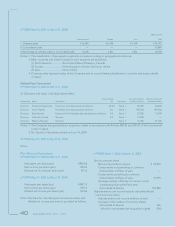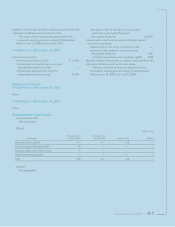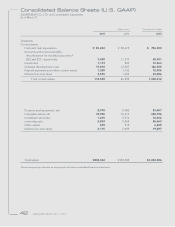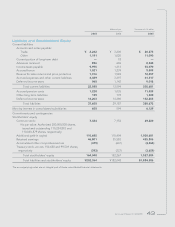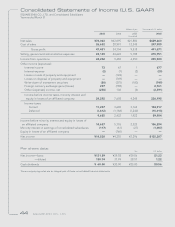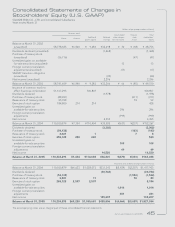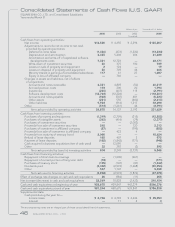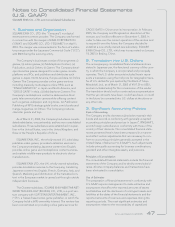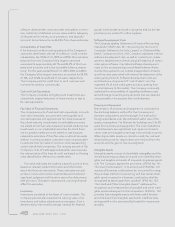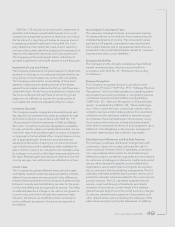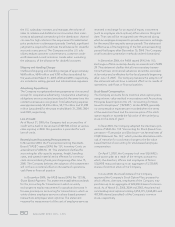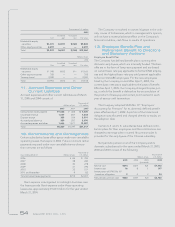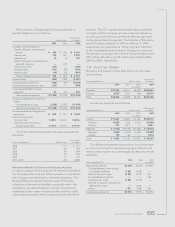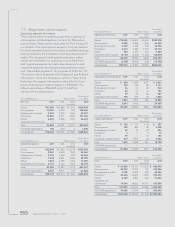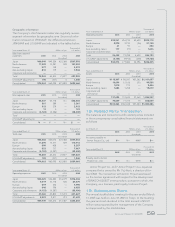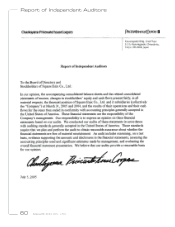Square Enix 2005 Annual Report Download - page 52
Download and view the complete annual report
Please find page 52 of the 2005 Square Enix annual report below. You can navigate through the pages in the report by either clicking on the pages listed below, or by using the keyword search tool below to find specific information within the annual report.
50 SQUARE ENIX CO., LTD.
the U.S. subsidiary monitors and manages the volume of
sales to retailers and distributors and monitors their inven-
tories as substantial overstocking in the distribution channel
can result in high returns or the requirement for substantial
price protection in subsequent periods. Similarly, significant
judgment is required to estimate the allowance for doubtful
accounts in any period. The Company and the U.S. sub-
sidiary analyze customer concentrations, customer credit-
worthiness and current economic trends when evaluating
the adequacy of the allowance for doubtful accounts.
Shipping and Handling Charges
Outbound shipping and handling charges of approximately
¥634 million, ¥545 million and ¥350 million (unaudited) for
the years ended March 31, 2005, 2004 and 2003, respectively,
are included in selling, general and administrative expenses.
Advertising Expenditures
The Company recognizes advertising expense as it is incurred
except for cooperative advertising. Cooperative advertising
obligations are accrued and amortized at the same time the
related revenues are recognized. Total advertising expense
was approximately ¥5,346 million, ¥5,119 million and ¥1,288
million (unaudited) for the years ended March 31, 2005, 2004
and 2003, respectively.
Line of Credit
As of March 31, 2005, the Company had an unused line of
credit with a bank in the amount of ¥29,500 million at various
rates expiring in 2006. No guarantee is provided for such
line-of-credit.
Recently Issued Accounting Pronouncements
In November 2004, the Financial Accounting Standards
Board (“FASB”) issued SFAS No. 151,
Inventory Costs, an
amendment of ARB No. 43
. This statement clarifies the
accounting for idle capacity expense, freight, handling
costs, and wasted material and is effective for inventory
costs incurred during fiscal years beginning after June 15,
2005. The Company believes the adoption of this statement
will not have a material effect on its results of operations,
cash flows or financial position.
In December 2004, the FASB issued SFAS No. 123 (R),
Share Based Payment
. This statement establishes standards
for the accounting for transactions in which an entity
exchanges its equity instruments for goods and services. It
focuses primarily on accounting for transactions in which an
entity obtains employee services in share-based payment
transactions (employee stock options). The statement
requires the measurement of the cost of employee services
received in exchange for an award of equity instruments
(such as employee stock options) at fair value on the grant
date. That cost will be recognized over the period during
which an employee is required to provide services in exchange
for the award (the requisite service period). This statement
is effective as of the beginning of the first annual reporting
period that begins after December 15, 2005. The Company
is still considering transition methods under this standard.
In December 2004, the FASB issued SFAS No. 153,
Exchanges of Non-monetary Assets, an amendment of APB
29
. This statement clarifies that all non-monetary transac-
tions that have commercial substance should be recorded
at fair value and is effective for the fiscal periods beginning
after June 15, 2005. The Company believes the adoption of
this statement will not have a material effect on its results of
operations, cash flows or financial position.
Stock-Based Compensation
The Company accounts for its incentive stock option plans
using intrinsic value method in accordance with Accounting
Principles Board Opinion No. 25, “
Accounting for Stock
Issued to Employees
” (“APB25”). Under APB25, generally
no compensation expenses are recorded when the terms
of the award are fixed and the exercise price of the stock
option equals or exceeds the fair value of the underlying
stock on the date of grant.
In fiscal 2003, the Company adopted the disclosure pro-
visions of SFAS No. 148 “
Accounting for Stock-Based Com-
pensation—Transaction and Disclosure—an Amendment of
FASB Statement No. 123,
” which provides alternative meth-
ods of transition for a voluntary change to the fair value
based method of accounting for stock-based employee
compensation.
On April 1, 2003, the Company took over SQUARE’s
stock option plan as a result of the merger, pursuant to
which, the directors, officers and employees of former
SQUARE may purchase up to an aggregate of 3,330,895
shares of common stock of the Company.
In June 2004, the stockholders of the Company
approved the Company’s Stock Option Plan, pursuant to
which officers, directors, employees of the Company may
purchase up to an aggregate of 600,000 shares of common
stock. As of March 31, 2005, 2004 and 2003, the plans had
outstanding stock options totaling 3,258,775, 3,262,645 and
487,400 shares (unaudited) of the Company’s common
stock, respectively.


